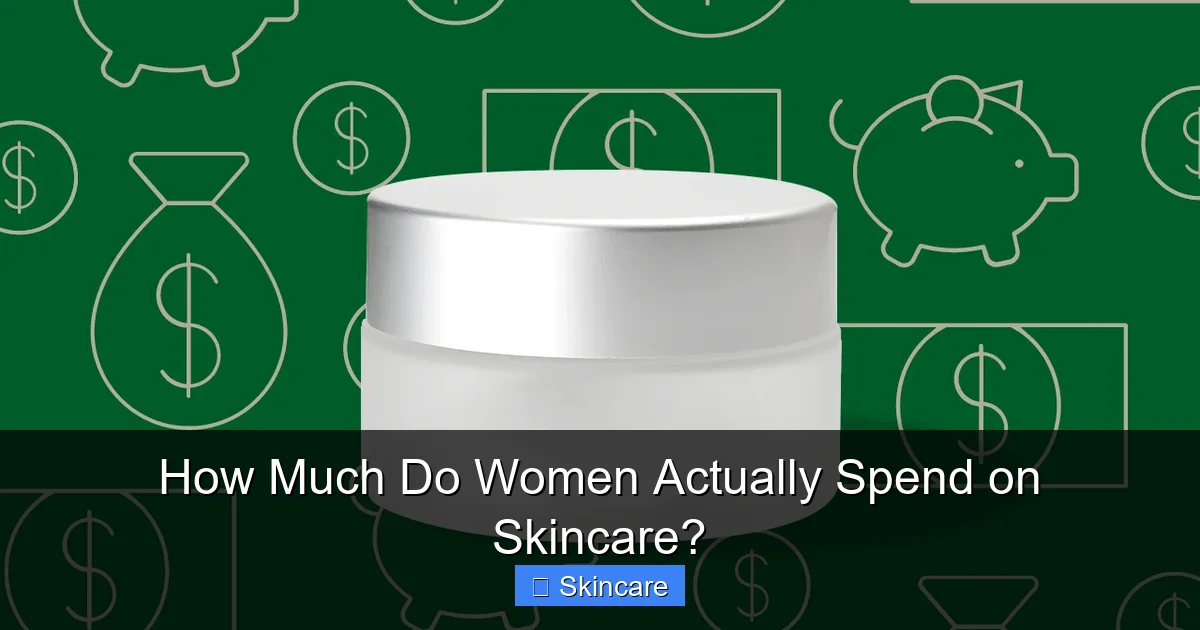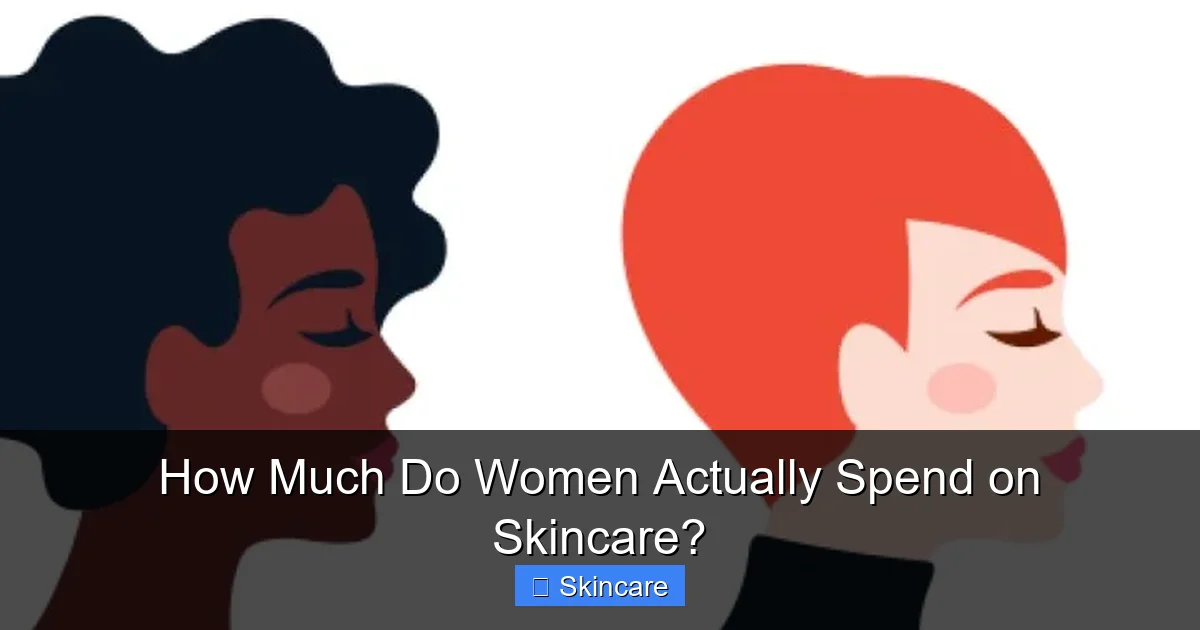
Featured image for this comprehensive guide about how much do women spend on skincare
Image source: chatelaine.com
Ever wondered how much the average woman truly invests in her glow-up routine? You’re not alone! In a world brimming with innovative products, viral trends, and personalized regimens, the question of “how much do women spend on skincare” is one that crosses many minds. From drugstore staples to high-end serums, the options are endless, and so too can be the bill.
Skincare isn’t just about vanity; for many, it’s a vital part of self-care, a preventative measure against aging, or a solution for challenging skin concerns. But what does this dedication cost? Let’s peel back the layers and uncover the real skincare spending habits of women today, exploring the factors that influence these budgets and how you can get the most out of your own skincare budget.
📋 Table of Contents
- The Skincare Spending Spectrum: It’s Not One-Size-Fits-All
- Diving into the Data: Average Skincare Spending
- The Skincare Shopping Cart: Where Does the Money Go?
- Beyond the Bottle: Hidden Skincare Costs
- Smart Skincare Spending: Tips to Optimize Your Budget Without Compromise
- The True Value: Why Women Invest in Skincare
The Skincare Spending Spectrum: It’s Not One-Size-Fits-All
When it comes to answering “how much do women spend on skincare,” there’s no single, simple number. The reality is a wide spectrum, influenced by a multitude of personal factors. Some women might spend a modest sum on a few essential products, while others might allocate a significant portion of their discretionary income to a comprehensive, multi-step regimen. The beauty industry is vast, catering to every price point and need.
Factors Influencing Skincare Budgets
Several key elements dictate a woman’s skincare expenses:
| Spending Category | Estimated Annual Spend | Key Drivers / Product Focus |
|---|---|---|
| Overall Average Woman | $900 – $1,200 | Daily essentials (cleanser, moisturizer, SPF), some targeted treatments. |
| Basic Routine Users | $300 – $600 | Focus on core hygiene and hydration with budget-friendly products. |
| Comprehensive Routine Users | $1,200 – $2,500 | Integration of serums (Vitamin C, Hyaluronic Acid), eye creams, masks, toners. |
| Luxury & Advanced Care Users | $2,500+ | Premium brands, specialized devices, professional treatments (e.g., facials, peels). |
| Younger Demographic (18-24) | $600 – $1,000 | Acne treatments, preventative care, trending products, occasional splurges. |
- Age and Life Stage: Younger women might focus on acne treatments and sun protection, often with more budget-friendly options. As women age, concerns shift to anti-aging, hydration, and repair, often leading to investments in more potent, sometimes pricier, ingredients and formulations.
- Skin Concerns: Those dealing with chronic conditions like severe acne, rosacea, or hyperpigmentation might invest more in specialized, often medical-grade, products or professional treatments, significantly increasing their cost of skincare.
- Lifestyle and Income: Disposable income naturally plays a huge role. Women with higher incomes may feel more comfortable splurging on luxury brands or advanced treatments. Lifestyle factors like sun exposure or pollution levels can also influence the need for specific, potentially more expensive, protective or restorative products.
- Brand Loyalty and Philosophy: Some prefer accessible drugstore brands, finding them effective and affordable. Others are drawn to clean beauty, organic, or scientific brands, which can come with a higher price tag due to ingredients, research, or sustainable practices.
- Influencer and Marketing Impact: Social media and beauty influencers often drive interest in new, trending, or premium products, which can subtly inflate a woman’s skincare budget over time.
Diving into the Data: Average Skincare Spending
While individual spending varies widely, research and market analysis provide insights into general trends and averages. Various studies and surveys aim to quantify “how much women spend on beauty products,” including skincare.

Learn more about how much do women spend on skincare – How Much Do Women Actually Spend on Skincare?
Image source: publish.purewow.net
It’s challenging to pinpoint an exact global average, but reports often suggest that women can spend anywhere from $50 to $500+ per month on skincare, with a significant portion falling in the $100-$200 range for those with a dedicated routine. Annual spending can therefore range from a conservative $600 to upwards of $6,000 or more, especially when factoring in professional services.
Monthly vs. Annual Skincare Expenses
Many women replenish their core products (cleanser, moisturizer, SPF) every 1-3 months, while serums and specialized treatments might last longer. This staggered purchase pattern can make it seem like monthly costs are lower, but the annual total can be quite substantial. For instance, a woman might spend $50-$100 on basic replenishments one month, and then $200-$300 on a new serum or anti-aging treatment the next. Calculating the average skincare cost truly requires an annual perspective.
Regional Differences in Skincare Spending
Skincare spending also differs geographically. Women in regions like South Korea and Japan, known for their elaborate multi-step routines, tend to have higher skincare spending habits. Similarly, in affluent Western markets, premium and luxury skincare products command higher prices and often find willing buyers, contributing to higher average expenditures compared to emerging markets.
The Skincare Shopping Cart: Where Does the Money Go?
To understand the breakdown of skincare expenses, it helps to look at the types of products women typically buy. The categories range from daily necessities to targeted treatments and occasional splurges.

Learn more about how much do women spend on skincare – How Much Do Women Actually Spend on Skincare?
Image source: rejuvage.com
Essential Staples vs. Targeted Treatments
Most women maintain a core routine of:
- Cleanser: Ranging from $10-$60+
- Moisturizer: Ranging from $15-$150+
- Sunscreen: Ranging from $10-$70+
These are often replenished regularly. Beyond the basics, the cost of skincare escalates with targeted treatments:
- Serums (Vitamin C, Hyaluronic Acid, Retinoids): These can be the most expensive individual items, often ranging from $30 to $200+ per bottle, depending on ingredients and brand.
- Eye Creams: Typically $20-$100+.
- Masks: Sheet masks can be $5-$15 each, while jar masks might be $20-$80+.
- Toners/Essences: $15-$80+.
The addition of just a few serums can easily double or triple one’s monthly or quarterly outlay on skincare products.
The Lure of Luxury and Medical-Grade Skincare
For those looking for advanced formulations or a sensory experience, luxury and medical-grade skincare brands represent a significant investment. Products from brands like La Mer, SK-II, Augustinus Bader, or those found in dermatologists’ offices can command prices upwards of $100, $300, or even $500 for a single product. These products often boast patented ingredients, extensive research, and high concentrations of active compounds, leading to a higher average skincare cost for consumers who choose them.
Beyond the Bottle: Hidden Skincare Costs
The money spent on products in bottles and jars isn’t the whole story. Many women also invest in professional services and devices that contribute significantly to their overall skincare expenses.
Professional Treatments and Services
For many, effective skincare extends beyond what can be achieved at home. Professional treatments include:
- Facials: Ranging from $80-$300+ per session, often recommended monthly or quarterly.
- Chemical Peels: $100-$500+ per session.
- Microdermabrasion/Microneedling: $150-$700+ per session.
- Laser Treatments (e.g., for hyperpigmentation, redness, hair removal): Can cost hundreds to thousands of dollars for a series of treatments.
- Botox/Fillers: These cosmetic procedures are increasingly viewed as part of an integrated anti-aging skincare regimen, costing hundreds to thousands per treatment area.
These services, while not daily purchases, add considerably to the overall amount women spend on skincare annually.
Skincare Device Investments
The market for at-home skincare devices has exploded. Women are investing in gadgets like:
- LED Light Therapy Masks: $100-$500+
- Microcurrent Devices: $150-$400+
- Facial Cleansing Brushes: $50-$200+
- Dermarollers: $20-$100+
These are often one-time or infrequent purchases, but they represent a substantial initial outlay that boosts the total skincare budget.
Smart Skincare Spending: Tips to Optimize Your Budget Without Compromise
Understanding how much do women spend on skincare can be eye-opening, but it doesn’t mean you have to break the bank for beautiful skin. Here are actionable tips to manage your skincare budget effectively:
Prioritize Your Needs
Identify your primary skin concerns. Do you struggle with acne, dryness, or aging? Focus your investment on 2-3 key products that target these issues most effectively. A good cleanser, moisturizer, and SPF are non-negotiables. After that, choose one potent serum for your biggest concern.
Research and Read Reviews
Don’t fall for marketing hype. Before making a purchase, especially for higher-ticket items, thoroughly research ingredients, read expert reviews, and check user testimonials. Sometimes, a more affordable product with proven ingredients can outperform an expensive one.
Look for Sales and Duplicates
Stock up on your go-to products during sales events like Black Friday or brand-specific promotions. Many effective active ingredients (like hyaluronic acid or vitamin C) are available across different brands at various price points. Research “dupes” – more affordable alternatives to popular high-end products.
Don’t Forget Consistency
The most expensive products won’t work if you don’t use them consistently. A consistent, simple routine with affordable products will always yield better results than an elaborate, expensive one used sporadically. This is crucial for maximizing the return on your skincare investment.
Consider Multi-Tasking Products
Look for products that serve multiple purposes. For example, a moisturizer with SPF, or a serum that combines several active ingredients, can reduce the number of products you need, thus saving money and simplifying your routine.
The True Value: Why Women Invest in Skincare
At the end of the day, the question isn’t just “how much do women spend on skincare,” but rather, “why do they spend it?” The answer lies in the perceived value. Skincare is an investment in oneself – in confidence, in health, and in feeling good.
From maintaining a youthful appearance to managing chronic skin conditions, the benefits of a well-executed skincare routine often outweigh the cost of skincare for many. It’s about empowering women to put their best face forward, feeling comfortable and confident in their skin, and practicing a form of self-care that reaps both immediate and long-term rewards. Whether your skincare budget is modest or luxurious, the goal remains the same: healthy, radiant skin that makes you feel great.
🎥 Related Video: How Much Time Women Spend on Beauty
📺 Stuff Mom Never Told You
Just how much time this year will the average woman spend putting on makeup, styling hair, shaving legs and other daily beauty …
Frequently Asked Questions
How much do women actually spend on skincare?
The amount women spend on skincare varies significantly, but studies often suggest an average of $15-$50 per month, with some spending hundreds annually. This range depends heavily on individual income, desired product quality, and specific skin concerns.
What is the average monthly skincare budget for women?
On average, women might allocate anywhere from $20 to $70 per month towards their skincare routine. This can include repurchasing staples like cleansers and moisturizers, as well as investing in serums or treatments.
What factors influence how much women spend on skincare products?
Several factors influence spending on skincare products, including age, income level, specific skin concerns (like acne or anti-aging), and brand preference. Marketing trends, ingredient quality, and the desire for specialized treatments also play a significant role.
Does age play a significant role in women’s skincare spending habits?
Yes, age often plays a significant role in women’s skincare spending. Younger women might focus on basic care and acne solutions, while older women typically invest more in anti-aging treatments, specialized serums, and products targeting specific concerns like fine lines and loss of firmness.
Which types of skincare products do women typically spend the most on?
Women tend to spend the most on targeted skincare products such as serums, anti-aging creams, and specialized treatments. High-quality moisturizers and cleansers are also significant purchases, often reflecting an investment in foundational skin health.
Why do women invest so much in skincare?
Women invest in skincare for a variety of reasons, primarily to maintain healthy skin, address specific concerns, and boost confidence. Skincare is often viewed as an essential part of self-care and a preventative measure for long-term skin health.
